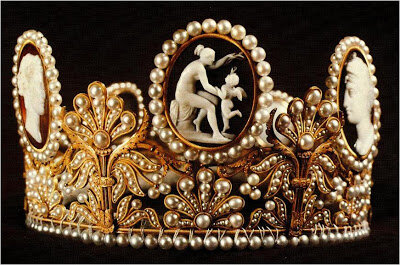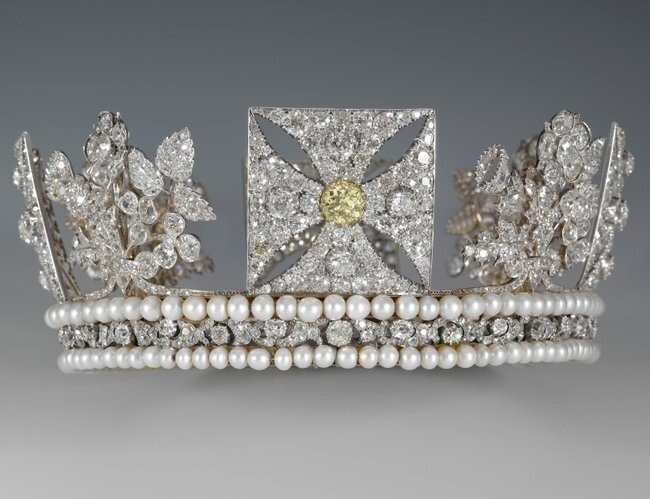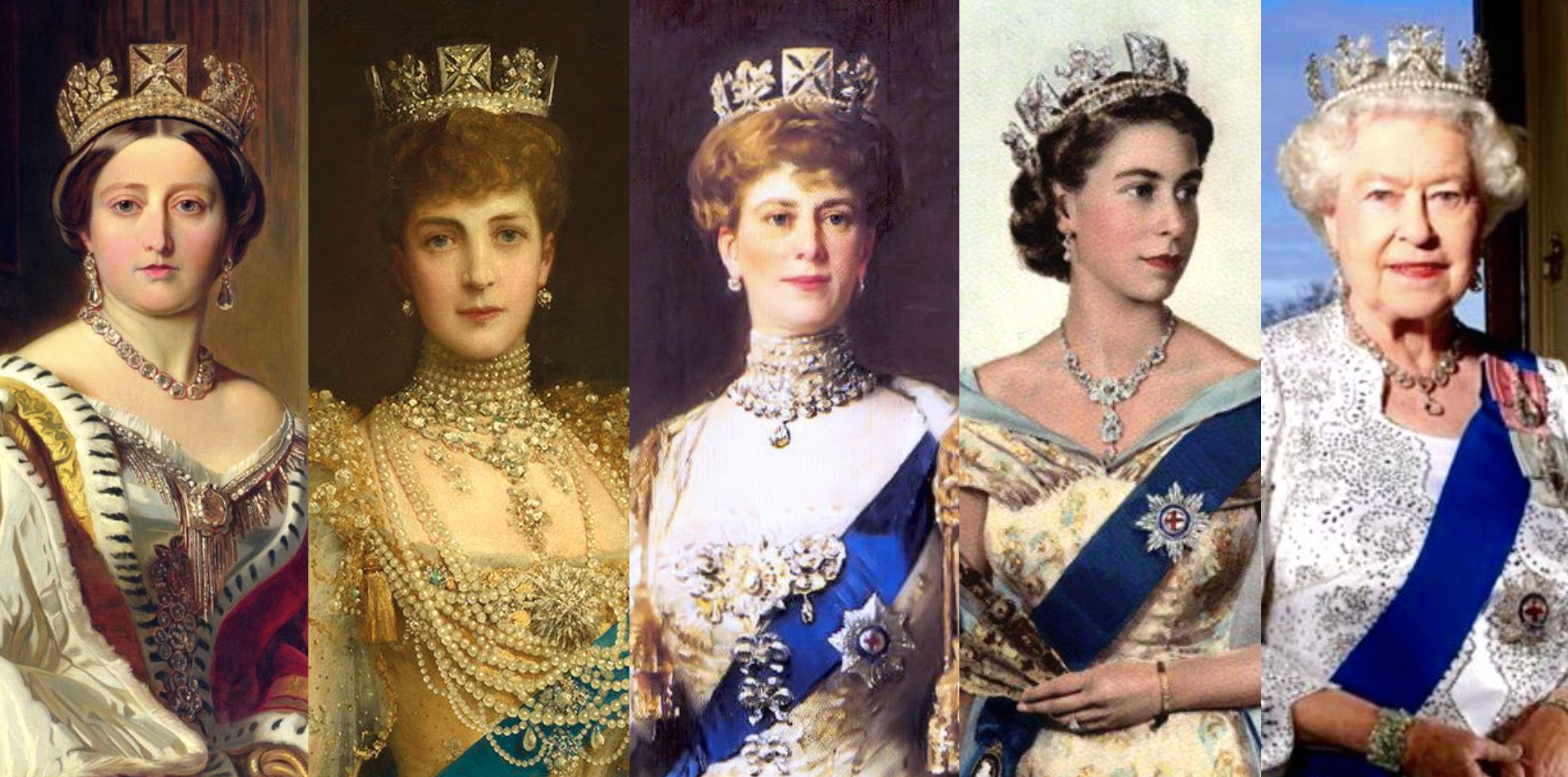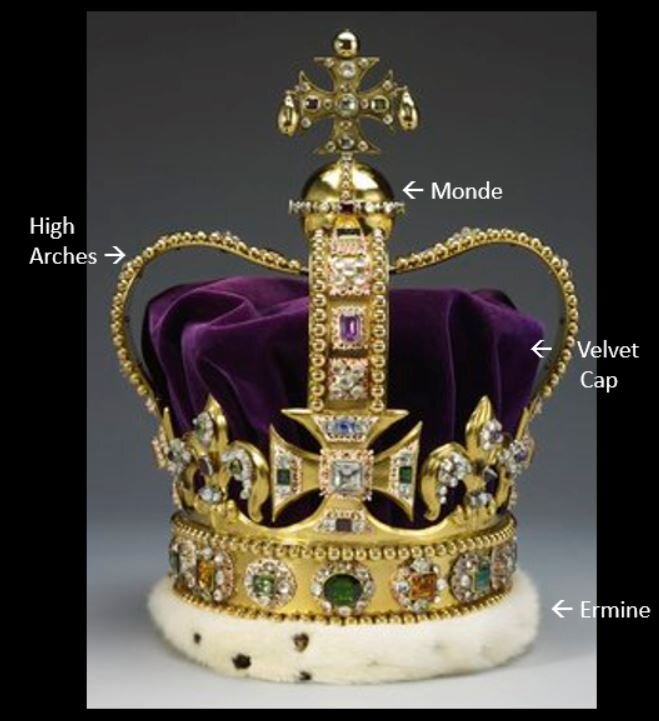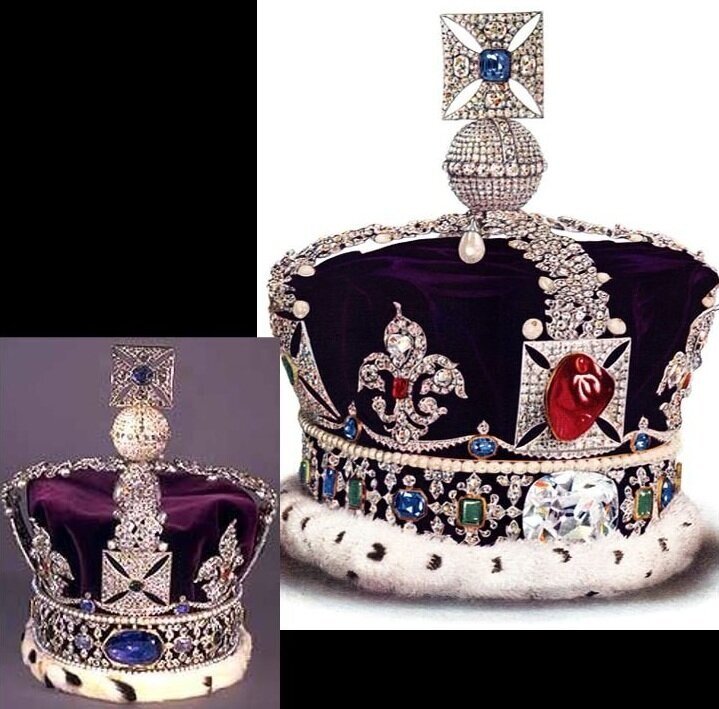Diadems, Tiaras, and Crowns, Oh My!
Other Posts about Crowns and Tiaras:
Disney Crowns and Tiaras: Historical and Modern Inspirations (Part I) - Snow White, Alice in Wonderland (cartoon and live), Sleeping Beauty/Maleficent, Robin Hood, and the Great Mouse Detective
Disney Crowns and Tiaras: Historical and Modern Inspirations (Part II): Cinderella, Little Mermaid, The Princess and the Frog, and The Sword in the Stone!
The Medals, Sashes, and Tiaras of The Crown; Tiaras/Crowns Overviews: Season 1 ; Season 2
So I’ve been hosting virtual lecture parties lately, since we’re all self-isolating and cooped up. At the most recent one, I presented on Diadems, Tiaras, and Crowns - talking about the different types and specific examples of each type. I had a lot of fun pulling together this slideshow and included as many pictures from around the world as I could.
The Diadem of Ravenclaw from Harry Potter and the Deathly Hallows
Princess Eugenie of the UK wearing the Greville Emerald Kokoshnik Tiara (1919)
(Credit: WPA Pool / Getty)
The Crown of Saint Wenceslas (Bohemia, 1347)
So I’ve been hosting virtual lecture parties lately, since we’re all self-isolating and cooped up. At the most recent one, I presented on Diadems, Tiaras, and Crowns - talking about the different types and specific examples of each type. I had a lot of fun pulling together this slideshow and included as many pictures from around the world as I could. My specific examples though, are all English/UK in origin, as that’s my passion and it’s frankly just a lot easier to find information on these than many of the other crowns and tiaras out there.
I will be putting all the information into blog post format at some point, but that’s going to take me a while because - lots of formatting and image upload! For today, I’m just loading up the slideshow so y’all can look through it at your leisure. Enjoy! If you have any questions, feel free to ask; I love talking about this sort of stuff!
Diadem of Princess
Sit-Hathor Yunet
(19th century BC, Egypt) (Credit: Hans Ollermann)
Greco-Roman bust (100 BC-100 AD)
17th Dynasty diadem (1580-1550 BC, Egypt)
Diodotus of Bactria on a coin, (first century AD, around modern Afghanistan)
Diadems:
• Diadem – refers to any circular piece worn on the head to symbolize status and power.
• Name originates from the Greek diadein - “to bind around”
• Early diadems were just ribbons or laurel wreaths.
• Crowns, tiaras, coronets, and other royal headpieces all fall under the diadem umbrella.
• Very few crowns are known by this title today. I could only find one modern one.
Replica, Imperial Crown of Russia (1762-1917)
Pahlavi Crown (1926, Iran)
Holy Roman Empire (11th century – 1806)
Crown of Japanese
Emperor Kōmei (1846-1867)
Crown from Kathmandu Valley (13th century, Nepal) (Credit: Sepia Times / Getty)
Imperial Crown of Brazil (1841)
Silla (5th-7th centuries, modern day Korea)
The Iron Crown of Lombardy (4th-5th century, modern day Italy)
Crowns:
• Crown – A full circle headpiece with an emblematic function associated with sovereignty and nobility.
• Open crowns, without bands overhead, are the oldest crowns, but closed crowns became the most popular ones in the middle ages and are the dominant type today.
Baronial Coronet (modern, UK)
Ducal Coronet (modern, Sweden)
Margaret of York (sister of Edward IV and Richard III) (1454, England)
Charles, Prince of Wales (1969, UK)
(Credit: Royal Collection Trust)
Coronets:
Coronet – Small crown generally worn by dukes and earls at coronations, and often worn by princes/princesses at formal events.
• These are standardized for various peers, with different designs for each rank (e.g., Duke, Marquess, Earl, Viscount, Baron).
• Very often seen in heraldry on coats of arms and shields
• I really couldn’t find evidence of actual coronets outside of Europe, so it may just be a weird Europe only thing. It looks like they’re more often used in heraldry, like on coats of arms, then in real life – I struggled to find any pictures of them.
• Charles’s coronet for his investment in 1969 was controversially modern and abstract. A new one had to be made after his great-uncle, the former Edward VIII, took his into exile after he abdicated the throne. The designer used electroplating to make the crown, which hadn’t been used before, and was unsatisfied with how the orb kept coming out until a technician suggested electroplating a ping pong ball. It worked.
Duchess of Angoulême (1820, France)
The Gandikj Diraja Tiara for the Raja Permaisuri Agong (1957, Malaysia)
A Pearl and Emerald tiara (420–589, China)
Empress Farah (1958, Iran)
Queen Rania’s Boucheron Emerald Leaves Tiara (2003, Jordan)
Cameo Tiara of Empress Josephine (1804, France)
Queen Margrethe II’s Aigrette (~19th century, Denmark)
(Credit: Pascal Le Segretain / Getty)
Tiaras:
• Tiara – An open semi-circular headpiece that usually does not encircle the head, but perches on the top.
• Worn by royal and noble women at white tie events, formal state occasions, and weddings.
• Traditionally, the wearer must be a bride or already married.
• Some tiaras are versatile and have elements that can be switched out or worn differently, such as brooches and different types of brooches.
• Really haven’t found many dating to before 1800 except this one from china in the top right corner
• They’re not worn before 6 pm except for weddings.
• Though tiaras used to be brightly colored, modern tiaras tend to be neutral colored.
• Parure – a jewelry set which usually includes tiara, necklace, brooch, sometimes a bracelet.
Queen Letizia floral tiara (1879, Spain)
Princess Mary’s Midnight Tiara (2009, Denmark)
(Credit: Pascal Le Segretain / Getty)
Princess Lalla Salma’s Tiara (2002, Morocco)
Part of the Nine Provinces Tiara (1926, Belgium)
The Ruby Olive Wreath Tiara (~1870s-1880s, Greece) (Credit: Pascal Le Segretain / Getty)
Princess Hisako’s tiara (modern, Japan)
Princess Tsuguko’s tiara (modern, Japan)
Queen Sirikit’s traditional tiara (1960, Thailand)
Dutch Aquamarine Parure Tiara (1927, The Netherlands)
Kinsky Honeysuckle Tiara (1870, Liechtenstein)
Citrine and Pearl Tiara (~1980s, Luxembourg)
A couple of specific examples! These are all English/UK in origin because that’s the history I know most about and frankly, it’s way easier to find details and information on these then most of the others.
Credit: Royal Collection Trust
George IV State Diadem:
• Made 1820 to be worn by George IV during his coronation procession.
• Traditionally worn by Queen Consorts at coronations and the state openings of Parliament, but Queens Regnant Victoria and Elizabeth II have worn it as well.
• Gold and silver frame, with strings of pearls, 1333 diamonds (over 320 carats), including a 4-carat yellow diamond, positioned on alternating crosses pattée and florals. The four florals represent roses, thistles and shamrocks, the flowers of England, Ireland, and Scotland.
• Crosses Pattee – type of Christian cross that appears very early in medieval art – extremely common in crowns in Christian countries
• Open Crown, in which the the head is open to the sky.
• Commonly appears on stamps and currency.
Queen Victoria, Queen Alexandra, Queen Mary, and Elizabeth II (both young and old), all wearing the diadem.
St. Edward’s Crown:
• First hereditary coronation regalia in Europe. The monks at Westminster Abbey claimed that Edward the Confessor asked them to look after his regalia for the coronations of all future English kings (although they probably just took it from his grave when he was reinterred there).
• A 1660 replica of Edward the Confessor’s crown, which was sold during the English Civil War. The medieval Crown dated to 1043. It was used in Richard II’s abdication in 1399, and was used to crown Anne Boleyn in 1533 (unprecedented for a consort).
• St. Edward’s Crown is 11.8 inches tall and 4.9 pounds. It’s made of gold, embellished with 444 stones, including amethysts, garnets, peridots, rubies, sapphires, topazes, tourmalines, and zircons.
•It has a closed Crown with high arches and a velvet cap trimmed in ermine
• From 1689-1911, monarchs chose to be crowned with a lighter, bespoke coronation crown personalized to each sovereign, while st. edward’s crown rested on the high altar.
• It’s currently used on royal arms of the UK, royal badges of England, the badges of the police forces of England and wales, the coastguard, british army, royal marines, royal airforce, and royal mail.
• This is a closed crown have bands around the temples and one or two bands over the head. Crowns with two bands or more usually for sovereigns; the prince of wales’ coronet only has one band. High arches in crowns are a symbol of sovereignty demonstrating that the king of England owed obedience to no one but God.
• The bottom is trimmed in ermine, which is very commonly seen in crowns, coronation cloaks, and peerage caps. Ermine comes from the winter coat of the stoat, which is a species of weasel with white fur and a black-tipped tail.
Imperial State Crown:
•Worn by the English monarch during the coronation when leaving Westminster Abbey and at the annual state opening of Parliament.
• A mere 2.3 pounds, compared to the 4.9 pound St. Edward’s Crown.
• It contains 2,901 precious stones, including the Black prince’s ruby and the Cullinan II on the front, St. Edward’s sapphire at the top, and the Stuart sapphire on the back.
St. Edward’s sapphire on the top cross is the oldest gemstone in the royal collection. Thought to have come from the coronation ring of Edward the Confessor from 1042.
Black Prince’s ruby – 170 carats = one of the oldest parts of the crown jewels, given to the black Prince in 1367. Henry V wore a gem-encrusted helmet that included this ruby. Mayyyy have been worn by Richard III on his helmet at the Battle of Bosworth, in which he died.
Stuart Sapphire on the back (lower left picture) – 104 carat - Probably belonged to Charles II and was definitely among the jewels that James VII took with him when he fled to France after the glorious revolution in December 1688.
• Fun fact: the arches are detachable, so the crown can also be worn as an open crown/circlet.
Credit: Peter Macdiarmid / Getty
Queen Mary’s Fringe Tiara:
• The tiara’s diamonds came from an 1893 necklace and the tiara was made in 1919.
• Diamond fringe tiaras were incredibly popular after they became fashionable at the imperial court of the Romanovs. There are numerous fringe tiaras like this in the royal collection and many of them can also be worn as necklaces.
• Worn by both the Queen and Crown Princess Anne at their weddings.
Credit: Peter Macdiarmid / Getty
Vladimir Tiara:
• Originally owned by Duchess Marie, a German princess who married Grand Duke Vladimir Alexandrovich in 1874.
• When the Grand Duchess fled from Russia in 1917, her jewels, including this tiara, remained in a hidden safe in Vladimir Palace. Later, her son and his friend disguised themselves as workmen, sneaked into the palace, and smuggled out the contents of her safe. This tiara was later sold by her daughter to Queen Mary of the UK, along with numerous other Russian imperial jewels.
• It can be worn with hanging emerald or pearl drops or it can be worn “widowed,” that is, without any drops.
Queen Mary, Diana, Princess of Wales, and Kate, Duchess of Cambridge
Queen Mary’s Lover’s Knot Tiara:
• This tiara is commonly referred to as the Cambridge Lover’s Knot Tiara, but in fact, it was only based off of that tiara. Queen Mary had this tiara created as a copy of the Cambridge tiara, which was owned by her cousin, using elements harvested from several other tiaras in her existing collection.
• In 1981, when Prince Charles married Diana Spencer, Queen Elizabeth presented her with several pieces of family jewelry, including this tiara, as lifetime loans. Diana wore this tiara very often and it became highly associated with her. In more recent times, the tiara has been sported most often by Diana’s daughter-in-law, Kate, the Duchess of Cambridge.
Credit: Getty
Credit: Royal Collection / PA
Queen Mary’s Diamond Bandeau (left):
• The Diamond Bandeau was made for Queen Mary in 1932 and specifically was made to feature the detachable brooch in the center. This brooch was given to Queen Mary in 1893.
• Meghan Markle wore the tiara for her wedding to Prince Harry in 2018. It was the first time the tiara had been worn in public in over 50 years.
• There are actually several tiaras in the royal family’s possession that haven’t been seen in public for 50-100 years!
The Girls of Great Britain and Ireland Tiara (right):
• The Girls of Great Britain and Ireland Tiara is one of the Queen’s most commonly worn tiaras.
• This was given to Queen Mary for her wedding in 1893 by a committee of women, which is where it gets its name. She presented it as a gift to then-Princess Elizabeth on her wedding day; the Queen still refers to it as “Granny’s Tiara.”

























